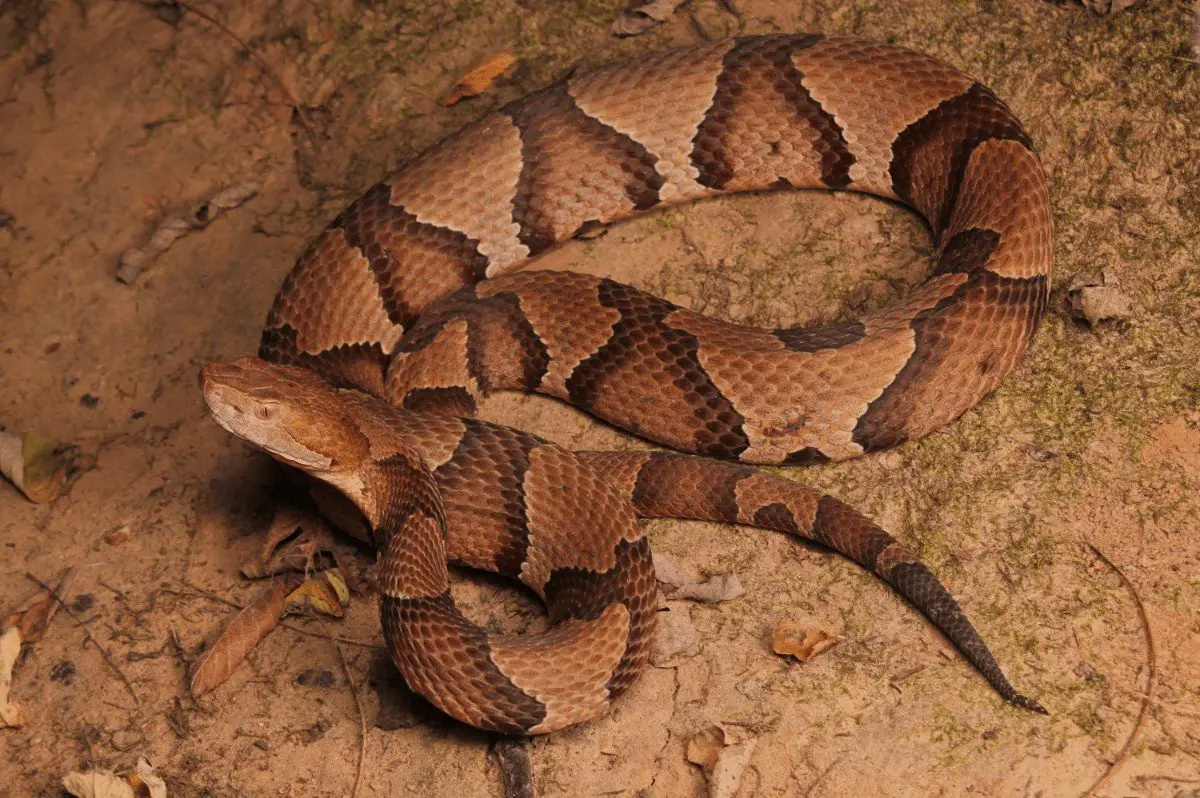Last Updated on July 20, 2022 by admin
Copperhead or Agkistrodon contortrix is a venomous snake that is mainly found in the eastern and central United States. Many people often confuse this snake with other snakes but it is different from them. This kind of snake is aggressive when provoked though its bite is not fatal. You should know it if you love spending your time hiking in the jungle and the snake also likes living near people’s homes.
Thus, if you want to know how to identify a copperhead snake, read on since this post outlines the features that make this species different from others.
Table of Contents
Features of a Copperhead Snake
The population of the copperhead snakes is very high in the US and thousands of cases of snakebites are also reported yearly. However, the snakebites are not fatal since the venom is not that poisonous. The snake bites if someone accidentally steps on it or when it finds itself under serious threat. Generally, copperhead snakes are human fearing creatures that do not just attack without being provoked.
Copperhead snake is also known as pit viper due to a pair of pits that are found between the nostrils and eyes to help it to detect heat. The pit also helps the snake to locate its prey even in the dark and it can also determine its size. The pit on the head of the snake acts as a sensor which helps it to improve accuracy and precision when it attacks the prey.
The snake kills the prey by biting it and releasing venom at the same time which affects the prey’s red blood cells thereby immobilizing it. It also regulates the amount of venom it releases depending on the size of the prey.
Out of interest, copperhead snake also has the following nicknames: hazel head, red adder, copper adder, highland moccasin, poplar leaf snake among others. The following are other features that can help you identify this kind of snake.
Color and Shape of the Head
A copperhead snake derives its name from the color of its head which is copper-red and it is just a fitting description. It also has some dots on top of its head. The other notable feature about this snake is that it has a triangle-shaped head which is also larger compared to its narrower neck.
The eyes of a copperhead snake consist of vertical pupils that resemble the cat’s eyes and the irises are ton or orange in color. The young copperheads are grayish in color but you can still identify them with the features of the adult ones.
Body Color
Copperhead snakes have camouflage patterns which make them difficult to spot. These snakes are not aggressive so they can freeze on the same position when disturbed and due to their camouflage patterns, you can hardly see them. The snake can conceal itself among dead brown leaves. However, if you unsuspectingly move very close to the snake, it can bite you in self-defense.
The most common colors of copperhead snakes are ruddy oranges and browns which help it to conceal itself in leafy habitat. The rest of its skin is copper brown in color snakes in mountainous places tend to have flecks which are black in color on their bodies.
The other feature that can help you identify the copperhead snake is that its base color is light. Its skin pattern on the back consists of “hourglass” shaped bands which are tan and brown and closer to black in color. The bands do not join and are narrowest near its backbone on top.
Body Size and Length
A copperhead snake has a thick body and a short tapering tail. When disturbed or when it readies to attack, it vibrates its tail but in most cases, the snake prefers to remain still while in a coiled position. The length of its body can reach three feet in maturity. If you see a snake with a slender body though it may fit this description, then you should know that it is not a copperhead.
Behavior of the Snake
You should also know the behavior of this snake so that you can easily identify it. The copperhead snake uses its camouflage pattern to protect itself. The snakes do not bite unless they are provoked and they just want to be left alone.
Once disturbed during its rest, a copperhead snake can get aggressive and it vibrates its tail fast while at the same time releasing a strong smell. Therefore, if you come face to face with a copperhead snake, just leave it alone and it will not attack you. Do not try to kill it, give it time and it will leave on its own because it does not want to be closer to humans. The snake is also excellent in catching rats.
In the event that you are bitten by a suspected copperhead snake, do not panic. Relax while you wait for medical assistance. This helps to avoid increasing your heartbeat which can also increase the movement of venom in your body.
Habitat of Copperhead Snakes
In most cases, copperhead snakes prefer to stay in wooded locations or closer to a water body where they can swim. This also helps them to waylay the prey that comes to drink water. They also like protected areas like abandoned buildings but they will never get into your house.
Copperhead snakes also enjoy basking under the sun when the weather is cool. The snakes move during the day but they can hunt at night when the temperature is warm.
Conclusion
Copperhead snakes are unaggressive creatures though they are responsible for a large number of snakebites in the US. They can be agitated when disturbed which leads them to bite people otherwise they do not just attack human beings. The camouflage pattern of the snake helps it to conceal itself and it is a defense mechanism.
Copperhead snakes also play a pivotal role in controlling the population of rodents so that it does not explode which can pose a threat to the health of humans. Therefore, there is no need to kill this type of snake which does not pose any danger if left alone.




